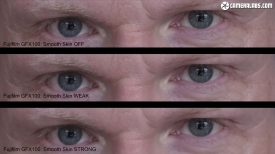Gordon from camera labs just released his final GFX100 review and it’s on the shorter side of his otherwise long videos, but I still made a summary of his points below, because they can go by quickly. It’s an interesting review because he approaches the GFX100 as being a specialty camera and treats the review more like one for a Ferrari than a more common car like a Mustang.
His review is relatively glowing with a few issues that could easily be addressed. If you do not have time to watch the video or the ability to turn the volume up and focus than the summary below should cover all of the points from the video above.
Image Quality
- Fujifilm GFX100 is almost twice the resolution of GFX50
- Pixel density is high but BSI should help
- Larger than full-frame, but smaller than more exotic sensors
- Phase One IQ doesn’t handle as well as GFX100 and works best in the studio on a tripod
- Photos from the GFX100 look excellent
- Great tones similar to Fujifilm’s X cameras
- Loves the film simulations
- 102MP lets you keep zooming in to enjoy finer details
- It’s amazingly easy to get high-quality 102MP pictures even handheld thanks to IBIS
- GFX100 builds on existing X cameras
- Smooth skin helps with portraits photography by smoothing skin and protecting eye details
- Gordon shows off smooth skin at 4:25
- Smooth skin works well, but it softened his eyelashes a little when set to strong
- If you shoot RAW you can try multiple levels of smoothing and pick the best
- Gordon shows the details of the GFX50 vs GFX100 in an interesting way at 6:00 and if it’s viewed full screen at 1080p the crop is about 200%, but in 4k it works out to about 400% with the 32-64mm
- GFX100 and GFX50 have similar noise levels
- GFX100 resolves more than the GFX50, but it works out to about 40% more horizontally
Handling
- First IBIS medium format camera
- He was able to handhold at about 1 stop under the one-over rule
- IBIS makes a big difference with composing and manually focusing
- IBIS is good in video
- Shows off IBIS vs no IBIS comparison at 64mm at 8:59
- Video IBIS does a great job of stabilizing filming and walking
Autofocus
- PDAF on the sensor for stills and movies, but make sure you update your lenses
- 32-64mm after AF is noticeably quicker to acquire focus
- GFX50S seems to be slower because of a lack of confidence
- PDAF improves handling
- Eye AF works well
- Continuous AF
- Very impressed with Continous eye AF, which is only matched by Sony
- 5fps continuous AF works well but is best for slower moving subjects like a dynamic photo session
Movies
- First medium format camera to capture 4k with all the desireable frame rates and aspect ratios
- 1-hour record limit
- He filmed 3 1hr 4k clips with the two fully charged batteries without issue
- Eterna is what he uses for clips because it delivers nice footage out of the camera
- h.264 records 8-bit internal and 10-bit HDMI
- h.265 records 10-bit internal and external
- Fujifilm should have included a full size HDMI port because the body has room and it’s more durable
- Continuous AF works well in video, but there is a little hesitation but hits the target without hunting
- Hopefully, the hesitation can be fixed with an FW update
- He even vlogs with the GFX100 successfully at 19:46 which stresses all the areas mentioned above
- Using an external recorder makes the whole setup much heavier
Conclusion
- The most usable and enjoyable medium format camera he has ever tested
- This is a camera you can take everywhere
- Stuck by how easy it is to enjoy the full 102MP
- The best image quality you can get without spending 5x as much
- No deal breakers for Gordon
- Doesn’t like the different feel between the grips
- VF blocks a lot of the screen when waste level shooting
- Sure you can take off the VF to shoot waste level, but you should have to
- Could solve the VF issue by bundling the tilt adapter with the camera
- There are some strangely small buttons
- Should have micro HDMI
- The price is going to be the biggest deal-breaker for most
- You can buy a 40-50MP Full Frame camera for less than 1/3 the price of the GFX100 and use tricks like multishot to match the resolution
- Of course, you can always rent a GFX100
- GFX100 has industry-leading image quality
- Gordon hopes features from the GFX100 will make their way down to the GFX50 line
Follow Fujiaddict on Facebook, Twitter, Instagram, and YouTube
Fujifilm GFX News, Rumors, and Collaboration
Fujifilm GFX Owners Group
Fujifilm GFX Page
Fujinon Premista 28-100mm T2.9: B&H Photo / Adorama
Fujinon Premista 80-250mm T2.9: B&H Photo / Adorama
Fujifilm GFX100: B&H Photo / Amazon / Adorama


